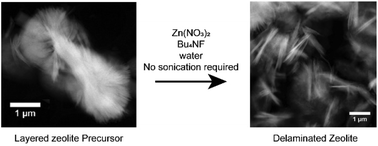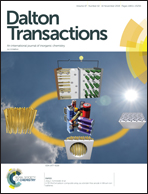SSZ-70 borosilicate delamination without sonication: effect of framework topology on olefin epoxidation catalysis†
Abstract
We report a scalable delamination procedure for a SSZ-70-framework layered-zeolite precursor, which for the first time does not involve either sonication or long-chain surfactants. Our approach instead relies on the mild heating of layered zeolite precursor B-SSZ-70(P) in an aqueous solution containing Zn(NO3)2 and tetrabutylammonium fluoride. Powder X-ray diffraction data are consistent with a loss of long-range order along the z-direction, while 29Si MAS NMR spectroscopy demonstrates preservation of the zeolite framework crystallinity during delamination. The resulting delaminated material, DZ-2, possesses 1.4-fold higher external surface area relative to the nondelaminated three-dimensional zeolite B-SSZ-70, based on N2 physisorption data at 77 K. DZ-2 was functionalized with cationic Ti heteroatoms to synthesize Ti-DZ-2 via exchange with framework B. Ti-DZ-2 contains isolated titanium centers in its crystalline framework, as shown by UV-Vis spectroscopy. The generality of the synthetic delamination approach and catalyst synthesis is demonstrated with the synthesis of delaminated material DZ-3, which is derived from layered zeolite precursor ERB-1(P) with MWW framework topology. Upon catalytic testing for the epoxidation of 1-octene with ethylbenzene hydroperoxide as oxidant, under harsh tail-end conditions that deactivate amorphous Ti-silica-based catalysts, Ti-DZ-2 exhibits the highest per-Ti-site activity, selectivity, and stability for 1-octene epoxidation of all catalysts investigated. This testing includes the prior benchmark delaminated zeolite catalyst in this area, Ti-UCB-4, which possesses similar external surface area to Ti-DZ-2 but requires sonication and long-chain surfactants for its synthesis. The synthesis of DZ-2 is the first example of an economical delamination of layered zeolite precursor SSZ-70(P) and opens up new doors to the development of delaminated zeolites as commercial catalysts.



 Please wait while we load your content...
Please wait while we load your content...
